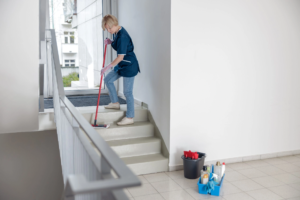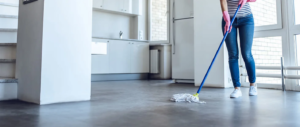[fsn_row][fsn_column width=”12″][fsn_text]
Scabies is an unpleasant and persistent skin condition caused by tiny mites that burrow into the skin, leading to intense itching and irritation. When someone in your household contracts scabies, it raises a critical question: How to clean your house after scabies? Effective cleaning plays a significant role in preventing re-infestation, and unfortunately, most resources focus solely on treating the skin while neglecting the importance of thoroughly cleaning your home environment. For West Vancouver residents, dealing with scabies can feel overwhelming, but with a detailed cleaning plan, you can effectively rid your home of these stubborn mites.
Understanding the Basics of Scabies Infestation
Before diving into the cleaning process, it’s essential to understand the scabies mite lifecycle. Scabies mites (Sarcoptes scabiei) can survive on human skin for up to 1-2 months, and while they don’t live long off a host (typically 48-72 hours), they can spread quickly in a home. Scabies spreads through direct skin contact or by sharing contaminated items like clothing, bedding, or furniture. According to a study by the American Academy of Dermatology, approximately 300 million cases of scabies occur annually worldwide, with about 10% of affected individuals experiencing recurrent infestations. For families in West Vancouver, this statistic highlights how easily scabies can return if proper cleaning isn’t done.
Step-by-Step Guide to Cleaning Your Home After Scabies
While treating your skin with prescribed creams and lotions is vital, the next priority is ensuring your home is thoroughly cleaned to prevent re-infestation. Here’s a detailed cleaning guide that covers what most websites don’t:
1. Washing Bedding, Towels, and Clothing
Scabies mites can easily transfer from skin to fabrics, so your bed sheets, clothing, towels, and anything that comes into direct contact with the skin need immediate attention.
- High Heat Washing: All clothing, towels, and bedding that the affected person has used in the past week should be washed in hot water (at least 60°C or 140°F) and dried in a hot dryer cycle. Scabies mites cannot survive high temperatures.
- Sealing Non-Washable Items: Any items that cannot be washed, such as delicate fabrics or stuffed toys, should be sealed in plastic bags for at least 72 hours, depriving the mites of a host and ensuring they die off.
2. Vacuuming Upholstered Furniture and Carpets
Many homeowners overlook how scabies can infest upholstered furniture and carpets, which can serve as a breeding ground for mites.
- Frequent Vacuuming: Thoroughly vacuum carpets, rugs, and all upholstered furniture, focusing on areas where the infested individual spent the most time. A high-quality vacuum with a HEPA filter can help ensure that mites and their eggs are effectively removed.
- Disposing of Vacuum Bags: After vacuuming, immediately dispose of vacuum bags or empty the vacuum canister into a sealed plastic bag to prevent mites from escaping.
3. Cleaning Hard Surfaces
Although scabies mites prefer fabric surfaces, cleaning hard surfaces is also crucial, as mites may have transferred to these areas through contact with infested items.
- Disinfecting Hard Surfaces: Use a disinfectant or scabies-killing spray to clean hard surfaces, such as countertops, bathroom fixtures, and furniture. A mix of bleach and water (1 part bleach to 9 parts water) can be used to disinfect these areas effectively.
4. Dealing with Mattresses and Furniture
Most people miss this step, but mattresses, pillows, and couches can harbor mites. Though scabies mites don’t live long without human skin, they can still remain for 48-72 hours.
- Vacuum and Steam Clean: After vacuuming mattresses and furniture, consider steam cleaning. The high heat from the steam will kill any lingering mites.
- Protective Covers: Encase your mattress and pillows in protective covers for at least 7 days. These covers act as a barrier and prevent mites from reaching you.
5. Don’t Forget the Car
If you’ve spent time in your car while infested with scabies, mites could have transferred to your car seats.
- Vacuum and Wipe Down: Thoroughly vacuum your car seats, paying close attention to areas where you sat. Wipe down all surfaces, including the dashboard and armrests, with disinfectant.
Read more about “What Is the Average House Cleaning Rate?” on our blog page today!
How ProClean Can Help West Vancouver Residents
Cleaning your home after scabies can be an exhausting task, and ensuring that every nook and cranny is free from mites can be a challenge. West Vancouver residents can turn to ProClean, a local cleaning service that specializes in comprehensive cleaning services West Vancouver, including scabies decontamination. At ProClean, we understand the importance of thoroughly cleaning the area after a scabies infestation. Our professional cleaning team uses advanced cleaning techniques and specialized equipment, such as HEPA filter vacuums and steam cleaners, to ensure your home is safe and mite-free. Whether you need help cleaning your carpets, furniture, bedding, or hard surfaces, ProClean offers tailored cleaning solutions for every corner of your home.
Lesser-Known Tips for Scabies Home Cleaning
Most articles skip over some critical cleaning strategies that can further protect your home from reinfestation:
- Freeze Items: Items that cannot be washed but might harbor mites, like certain shoes or accessories, can be placed in a freezer for 72 hours. The cold will kill the mites.
- Pay Attention to Pets: While scabies mites don’t infest animals, mange mites (closely related to scabies) can cause irritation in pets. Consider treating and cleaning your pet’s bedding and favorite resting spots.
- Rotate Bedding and Clothes: During treatment, it’s helpful to rotate fresh sheets, pillowcases, and clothing daily to ensure that any mites that might have survived on fabrics are removed quickly.
Preventing Scabies Reinfection
While cleaning is essential, you must also focus on preventing reinfection. Scabies can spread easily among family members, so it’s crucial that everyone in the household undergoes treatment, even if they aren’t showing symptoms. Additionally, avoid skin-to-skin contact and sharing of personal items until the infestation is fully cleared.
Conclusion
Cleaning your house after scabies can seem daunting, but by following a thorough cleaning protocol, you can rid your home of scabies mites and prevent re-infestation. Remember, effective treatment of scabies includes not only addressing the skin but also cleaning your home environment. For residents of West Vancouver, getting professional help can make all the difference. ProClean is here to help you every step of the way, providing specialized cleaning services West Vancouver that ensure your home is scabies-free.
If you’re struggling to rid your home of scabies mites, let ProClean take the burden off your shoulders. Our experienced team in West Vancouver uses specialized tools and techniques to make sure your home is thoroughly cleaned and safe. Don’t let the stress of cleaning after scabies overwhelm you—reach out to us today! With ProClean’s reliable services, you’ll have peace of mind knowing your home is clean and mite-free. Contact us now to schedule a professional deep clean and eliminate the risk of re-infestation!
[/fsn_text][/fsn_column][/fsn_row]





